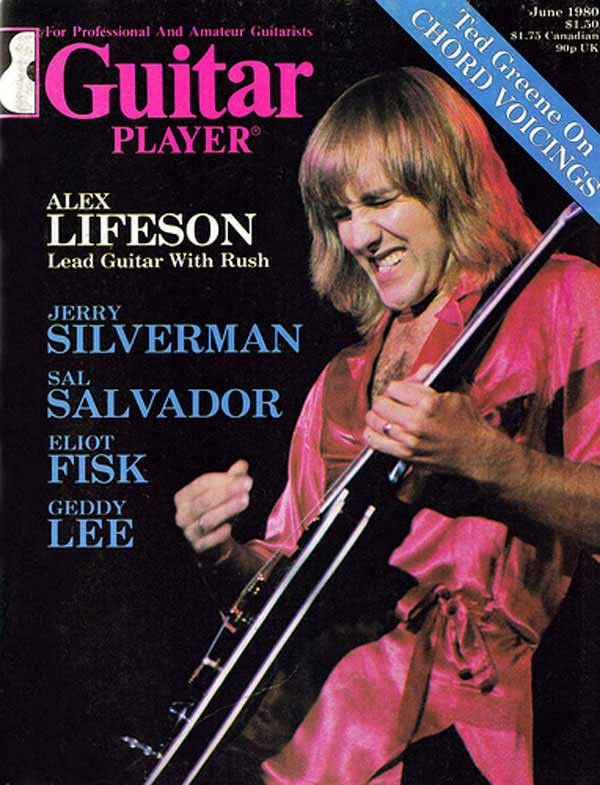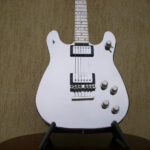Rush, the Canadian power trio, has captivated audiences worldwide with their complex compositions, thought-provoking lyrics, and unparalleled musicianship. At the heart of Rush’s signature sound lies the kinetic and innovative guitar work of Alex Lifeson. From the band’s inception in 1968 to their final performances, Lifeson has crafted a guitar style that is instantly recognizable and deeply influential, making him a true icon for aspiring and seasoned guitar players alike. This article delves into the multifaceted artistry of Alex Lifeson, exploring his evolution as a guitarist, his gear, techniques, and the indelible mark he has left on the landscape of rock music.
I. Early Influences and Formative Years: Building Blocks of a Unique Style
Alex Lifeson’s journey as a guitarist began in his childhood home in Toronto. His initial musical experiences were humble, starting with an inexpensive Kent classical guitar.
Alt text: Young Alex Lifeson of Rush playing a Kent classical guitar, showcasing his early instrument and passion for music.
This basic instrument, despite its limitations, became the foundation for Lifeson’s early explorations. Initially self-taught, Lifeson learned by ear, absorbing songs from the radio and experimenting with sounds. He recalls being drawn to the raw energy and innovative guitar work of bands like Cream and the Jimi Hendrix Experience, artists who were redefining the role of the guitar in rock music. The psychedelic era, with its emphasis on sonic exploration and extended instrumental passages, deeply resonated with the young guitarist.
While briefly considering formal lessons in classical and flamenco guitar, Lifeson’s path diverged towards the electric guitar, fueled by the burgeoning hard rock scene. His progression from the Kent classical to a Conora electric solidbody signaled a decisive shift towards the louder, more amplified world of rock. The influence of Eric Clapton’s iconic Gibson SG, as wielded in Cream, was a powerful visual and sonic inspiration, pushing Lifeson to seek a similar aesthetic and tone. These early years were characterized by experimentation, borrowing equipment, and jamming with childhood friend and future bandmate Geddy Lee. Basement bands playing covers of rock staples like “Gloria” and “(I Can’t Get No) Satisfaction” provided a crucial proving ground, honing their skills and solidifying their musical partnership.
The formation of Rush in 1968 marked a pivotal moment. Initially playing local gigs at drop-in centers and school dances, the band gradually built a local following. Lifeson’s guitar at this stage was still the Conora, reflecting his resourcefulness and determination to make music despite limited resources. Borrowing better instruments from friends, including a Harmony Les Paul-esque guitar and a Gibson Firebird, allowed him to expand his sonic palette and explore different guitar styles.
II. The Evolution of Gear: Crafting the Lifeson Sound
Lifeson’s acquisition of a 1968 Gibson ES-335 marked his entry into professional-grade instruments. This semi-hollow guitar, known for its versatility and rich tone, became a cornerstone of his sound for many years.
Alt text: Alex Lifeson playing his Gibson ES-335, a key guitar in shaping his Rush sound and demonstrating his mastery of the instrument.
Shortly after, a 1963 Fender Stratocaster joined his arsenal, adding a different tonal flavor and expanding his options. However, the Stratocaster initially presented challenges. Lifeson, accustomed to the Gibson’s neck profile and control layout, found the Strat’s maple neck and volume knob placement less comfortable. Despite these initial hurdles, the Stratocaster would eventually become an important part of his sonic toolkit, especially after modifications later in his career.
Throughout the early Rush albums, the ES-335 remained a central instrument. Paired with a Marshall 50-watt amplifier and effects like a Maestro phase shifter, Cry Baby wah-wah, and Echoplex, Lifeson began to define his signature guitar tone – a blend of power, clarity, and dynamic expression. The Roland Boss Chorus, introduced around the A Farewell to Kings era, became another crucial element, adding width and dimension to his guitar sound, particularly important in a power trio context.
As Rush’s sound evolved, so did Lifeson’s gear. He experimented with different Les Paul models, including a ’74 Les Paul Deluxe and later ’74 and ’76 Les Paul Standards. Amplification choices expanded to include Fender Super Reverbs, Twin Reverbs, and eventually Hiwatt and Mesa/Boogie amps. The Hiwatt amps, in particular, became associated with the powerful and articulate guitar sound of albums like Hemispheres and Permanent Waves.
The Gibson ES-355, acquired in 1976, became Lifeson’s primary guitar. Its heavier body and ebony fingerboard offered increased sustain and a slightly different tonal character compared to the ES-335. The ES-355’s robust construction also helped reduce feedback issues, a common challenge with semi-hollow guitars at high volumes. Lifeson also embraced double-neck guitars, initially a Gibson EDS-1275, allowing him to seamlessly switch between six and twelve-string sounds onstage, enriching Rush’s live performances and studio recordings.
Effects pedals played an increasingly important role in shaping Lifeson’s sound. Beyond the chorus and phaser, he incorporated flangers like the Electro-Harmonix Electric Mistress, digital delays, and parametric filters, expanding his sonic palette and adding textures to Rush’s complex arrangements. While briefly experimenting with guitar synthesizers like the Roland GR-500 and Zetaphon, Lifeson ultimately remained grounded in traditional electric guitar techniques, using synthesizers more for textural enhancement than as a primary instrument.
III. Technique and Style: The Kinetic Lead Guitarist in Action
Alex Lifeson’s guitar playing is characterized by its dynamism, versatility, and emotional depth. He seamlessly blends powerful riffs, soaring solos, and intricate chord voicings, creating a guitar style that is both technically impressive and deeply musical.
Alt text: Alex Lifeson in concert, showcasing his energetic stage presence and dynamic guitar solo style that defines him as a rush guitar player.
Rhythm Guitar Prowess: Lifeson’s rhythm guitar work is far from simply providing a backdrop for vocals and solos. In Rush’s power trio context, his rhythm playing is essential in creating a full and textured sonic landscape. He employs a wide range of techniques, including:
- Power Chords: The foundation of hard rock rhythm guitar, Lifeson uses power chords with precision and impact, driving Rush’s heavier songs.
- Arpeggios: Lifeson’s mastery of arpeggiation adds a layer of sophistication and texture to Rush’s music. Arpeggiated chords, often played with chorus and delay, create shimmering soundscapes and dynamic contrasts.
- Chord Voicings: Lifeson’s chord work is not limited to basic triads and power chords. He explores more complex voicings, adding color and harmonic interest to Rush’s compositions.
- Time Signature Mastery: Rush’s music is renowned for its complex and shifting time signatures. Lifeson’s rhythmic precision is crucial in navigating these intricate structures, providing a solid foundation for the band’s complex arrangements.
Lead Guitar Innovation: Lifeson’s solos are a hallmark of Rush’s sound, known for their melodicism, energy, and improvisational feel. His soloing style is a synthesis of influences, including:
- Blues-Rock Roots: The influence of blues-rock guitarists like Eric Clapton and Jimmy Page is evident in Lifeson’s bending techniques, vibrato, and emotive phrasing.
- Progressive Exploration: Lifeson’s solos are not confined to traditional blues scales. He incorporates more modal and chromatic ideas, reflecting the progressive nature of Rush’s music.
- Dynamics and Texture: Lifeson’s solos are characterized by their dynamic range, moving seamlessly between moments of fiery intensity and melodic introspection. He utilizes effects pedals to shape his solo tones, adding layers of texture and atmosphere.
- Spontaneity: Lifeson emphasizes the improvisational aspect of his solos, preferring to create in the moment rather than meticulously planning every note. This spontaneity contributes to the raw energy and excitement of his lead playing.
- Vibrato Arm Artistry: Inspired by guitarists like Allan Holdsworth, Lifeson incorporates the vibrato arm with subtlety and expressiveness, adding nuanced pitch variations and textures to his solos.
Classical and Acoustic Dimensions: Beyond his electric guitar work, Lifeson’s exploration of classical and acoustic guitar adds another dimension to Rush’s music. He incorporates classical guitar passages into songs like “La Villa Strangiato” and “Broon’s Bane,” showcasing his versatility and broadening Rush’s sonic palette. Acoustic guitars, often played in standard and Nashville tunings, feature prominently in songs like “The Trees” and “Different Strings,” adding warmth and texture to Rush’s arrangements.
IV. Key Albums and Guitar Moments: Tracing the Lifeson Legacy
Throughout Rush’s extensive discography, Alex Lifeson’s guitar work has been a constant source of innovation and inspiration. Several albums and specific tracks stand out as showcasing his evolving style and signature sound.
-
2112 (1976): This album marked a turning point for Rush, both commercially and artistically. Lifeson’s guitar work on the epic title track “2112” is a tour-de-force, ranging from powerful riffs to soaring, atmospheric solos. Tracks like “Lessons” (written solely by Lifeson) showcase his melodic sensibilities and songwriting contributions.
Alt text: Rush 2112 album cover, representing the band’s breakthrough album and featuring Alex Lifeson’s iconic guitar work that defined the rush guitar player sound.
-
A Farewell to Kings (1977): This album saw Rush further embracing progressive elements and expanding their instrumental palette. Lifeson’s use of guitar synthesizer and Taurus bass pedals began to emerge, adding new textures to the band’s sound. “Xanadu” features intricate guitar work and atmospheric soundscapes, while “Closer to the Heart” showcases his ability to craft memorable and melodic riffs.
-
Hemispheres (1978): Considered by many fans to be Rush’s most progressive album, Hemispheres is a showcase of instrumental virtuosity and complex compositions. “La Villa Strangiato,” an instrumental masterpiece, highlights Lifeson’s dynamic playing, incorporating classical guitar elements and showcasing his improvisational skills. The album’s title track, “Hemispheres,” features intricate arrangements and powerful guitar riffs.
-
Permanent Waves (1980): This album marked a slight shift towards shorter, more concise songs while retaining Rush’s progressive edge. “The Spirit of Radio” is a classic rock anthem featuring Lifeson’s iconic opening riff and dynamic solo. “Jacob’s Ladder” showcases his ability to create atmospheric textures and build intensity through his guitar work. “Different Strings” highlights his acoustic and electric guitar interplay, demonstrating his versatility.
-
Moving Pictures (1981): Rush’s most commercially successful album, Moving Pictures, features some of Lifeson’s most iconic guitar riffs and solos. “Tom Sawyer,” a rock radio staple, features a powerful and instantly recognizable guitar riff. “YYZ,” an instrumental track, showcases the band’s instrumental prowess and Lifeson’s dynamic lead playing. “Limelight,” a song reflecting on fame and the music industry, features a melodic and expressive guitar solo.
V. Enduring Influence and Legacy: A Rush Guitar Player for Generations
Alex Lifeson’s impact on rock guitar is undeniable. His innovative playing style, combined with his distinctive tone and compositional contributions, has made him one of the most respected and influential guitarists in progressive rock and beyond.
Alt text: Alex Lifeson in his element, performing live with Rush, embodying the persona of a rush guitar player and captivating audiences with his skill and stage presence.
As a “Rush Guitar Player,” Lifeson has inspired countless musicians with his:
- Unique Sound: His blend of power, clarity, and texture is instantly recognizable and has become a benchmark for progressive rock guitar tone.
- Versatile Technique: His mastery of rhythm guitar, lead playing, acoustic guitar, and classical guitar techniques demonstrates a breadth of skill rarely found in rock guitarists.
- Compositional Contributions: Lifeson’s songwriting contributions to Rush have been integral to the band’s sound and evolution, extending beyond simply guitar parts to shaping entire songs.
- Stage Presence: Lifeson’s energetic and engaging stage presence has made him a captivating performer, connecting with audiences on both a musical and visual level.
- Dedication to Craft: Lifeson’s continuous exploration of new gear, techniques, and musical ideas exemplifies a lifelong dedication to his craft, serving as an inspiration to aspiring musicians.
Alex Lifeson’s legacy extends beyond his technical prowess and gear choices. He embodies the spirit of musical exploration and innovation that is at the heart of progressive rock. As a “rush guitar player,” he has helped define the sound of a generation and continues to inspire guitarists worldwide to push boundaries and create music that is both technically challenging and deeply meaningful. His work with Rush stands as a testament to the power of musical collaboration, creativity, and the enduring impact of a truly unique guitar voice.


